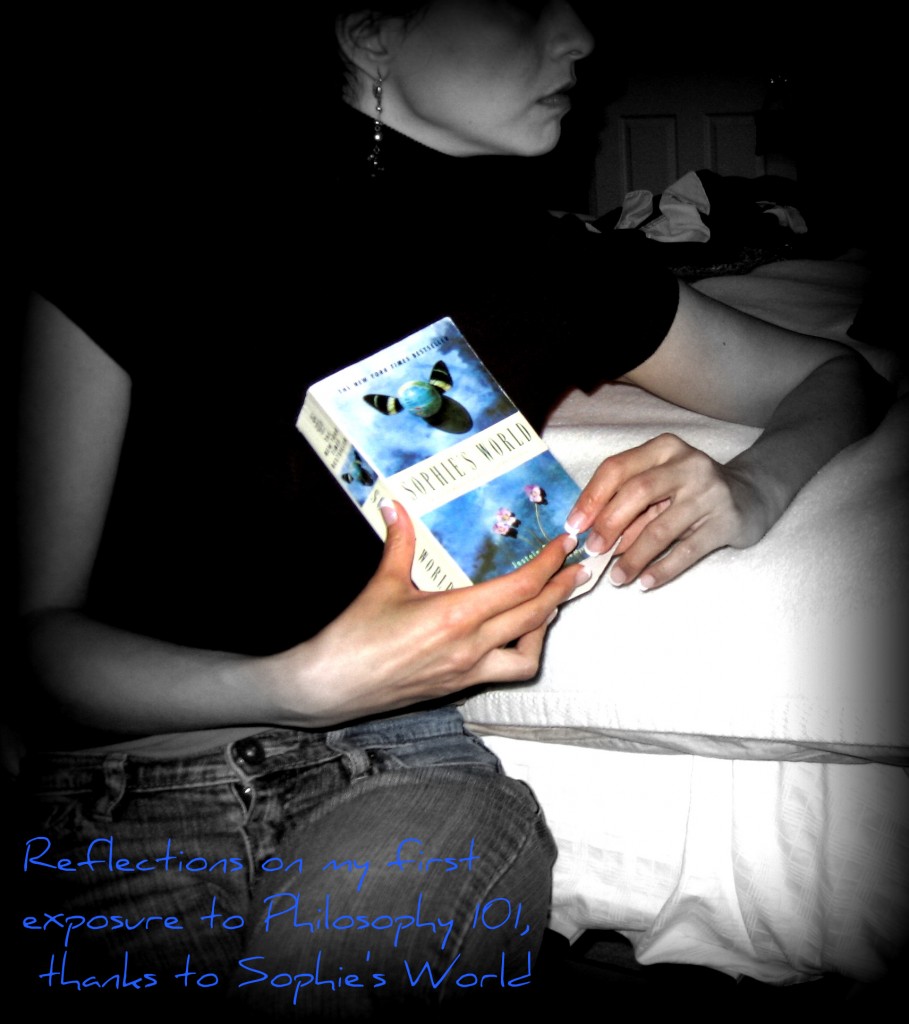“Sophie’s World” was a long, strange, and most unpredictable novel. This was my very first in-depth reading on philosophy. I read this book over the course of a month, while reading other books in parallel, and sometimes taking a break from it on purpose. Our main character is Sophie Amundsen. A history of philosophy wrapped in great fiction, I was greatly engrossed in Sophie’s story, thoughts and discoveries, and Jostein Gaarder is an intriguing novelist to boot.

The philosophy lessons are chronological and start at the very birth of philosophy with Socrates, Plato and Aristotle. This quick summary on Greek Philosophy can serve as the cliff-notes version of the first few hundred pages of Sophie’s World. Alberto Knox, the philosophy teacher who makes an appearance in Sophie’s life before her 15th birthday, takes us through the history of philosophy in scrupulous details. We touch on Socrates, then Plato and then Aristotle, and every other significant contributor to the field of philosophy from pre-Socratic Greeks to Jean Paul-Sartre. Sophie, meanwhile absorbing this fascinating topic like a new sponge to water, has a present mystery to solve: She is the confused recipient of numerous postcards from a Major Albert Knag who is stationed in Albania, all of which are intended for his daughter, Hilde Moller Knag.
This book is far better than a philosophy textbook and extremely authentic as a novel; the combination makes for an ideal way to learn about philosophy, a topic for which everyone needs a basic introduction. The questions Alberto Knox sends Sophie are questions that everyone asks, and a few spend a lifetime trying to answer:
- Where do we come from?
- What are thoughts?
- Are we living in a dream?
The discussions between Alberto and Sophie reach many layers of this ancient study of man and his theorization and rationalization about the world and universe at large. Alberto makes the lessons memorable without simplifying them for Sophie’s young mind. One of my favorite phrases from him is “Socrates is possibly the most enigmatic figure in the entire history of philosophy. He never wrote a single line.”
Even if you have taken Philosophy 101, you will be hard pressed to be knowledgeable on all the key thinkers and theories Alberto uncovers for us, tale after tale, chapter after chapter. In the “Myth of the Cave”, attributed to Plato, Alberto illustrates the key message that “…the relationship between the darkness of the cave and the world beyond corresponds to the relationship between the forms of the natural world and the world of ideas...”.
Reading is the best pastime for an active mind! If you like to see the other book reviews, check the index of In Print.
Alberto tells us that the highest degree of reality, and I paraphrase, in the world of Plato’s theory, was that which we think with our reason. On the contrary, for Aristotle, it was equally apparent that the highest form of reality is that which we perceive with our senses. Do the two have to be mutually exclusive – or can we attribute some truth to each? It may not be acceptable to subscribe to more than one philosophy, perhaps similar to subscribing to more than one religion.
Greece with its rich long history plays a significant part in this book and in the history of philosophy. Gaarder first acquaints Sophie with the period of Hellenism, which lasted about 300 years and marked a period of Greek-dominated culture that prevailed 3 kingdoms: Macedonia, Syria, and Egypt. We learn about the Cynics, the Stoics, and the Epicureans, as we travel through the history of religion. One of my favorite quotes in all of this book is Socrates gazing at a stall and exclaiming, “What a lot of things I don’t need.“ – so simplistic, and yet so true when audibly noted by a master.
Sophie’s world continues to evolve as her philosophy class goes on…..while we learn about the main German philosophers, the history of Christianity, the main figures who significantly influenced the thinking of our age or that of the current period in which they lived, strange things start to happen to Sophie. After the dog starts to talk to her, and the philosopher sends a tape of himself live from Athens (after having been just in Norway), I am torn between believing the nonsensical happenings to Sophie or predicting a completely different layer at work in the story. I am only too disappointed to find, almost half-way through this book if not further, that Hilde is indeed sitting in her room, reading the novel I am reading, and Sophie and Alberto are figments of imagination of her father (Albert Knag stationed in Albania) – they do not exist in the world of the novel as we had presumed them to be – two human beings on earth. Instead, Hilde is the little girl reading and learning about philosophy, which is carefully being played out in her father’s imagination, and animated by a Sophie and a Mr. Alberto Knox.
Jostein Gaarder’s novel has been referred to as an example of an unreliable narrator. His twisted plot, uncovered well into the book, deceives us cruelly. We have grown attached to Sophie and admire her courage for seeking the answers to the mystery of Hilde. To learn that Sophie was nothing more than a figment of Hilde’s father’s imagination was cruel – and yet it awakened me to realize that all of this book is just a figment of the author’s imagination – and so the same goes for the best, most timeless classics of our time. A poignant example to awaken us not into the disappointment in the role swap between Sophie and Hilde so much as to the power of imagination of a single individual. Perhaps I am happy to have been deceived after all!
As to the author’s narration style, I found little to like in his choice of words and I was not particularly fond of his prose in general. Perhaps, a few things got lost in the translation from Norwegian and originality was compromised. The very last chapter is definitely my favorite. I like how the story comes to a close while philosophy lessons are for life. I experienced highs and lows of motivation and interest reading this book – while I did not lose interest in Sophie, I had more than my share of philosophy – and yet, the book managed to bring me back every time. Some of best parts of the book take us through Charles Darwin‘s journeys to the New World (the current USA) and hence, the birth of his theories. Gaarder shares a glimpse on the mystery of our cosmos, the Big Bang theory and the mind-boggling facts around the vastness of our universe, its constant expansion, theories surrounding subjects of unreal complexity, and distances between the stars measured in light years. Whether we are in the field of science or not, we cannot but marvel at the cosmos and smile with awe at how much of nature, universe and existence mankind still cannot understand.
 I am Farnoosh, the founder of Prolific Living. So glad you are here. My mission is to empower you to unblock your creative genius to live your dream life.
I am Farnoosh, the founder of Prolific Living. So glad you are here. My mission is to empower you to unblock your creative genius to live your dream life.